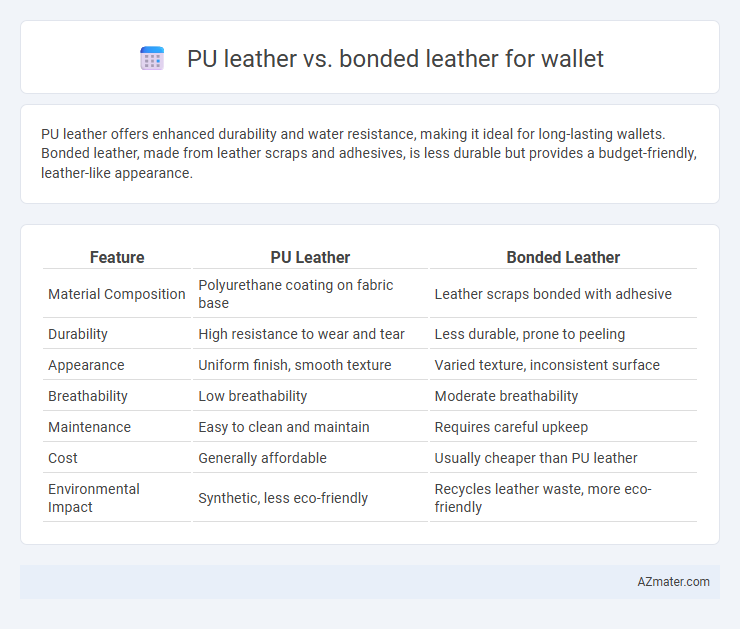PU leather offers enhanced durability and water resistance, making it ideal for long-lasting wallets. Bonded leather, made from leather scraps and adhesives, is less durable but provides a budget-friendly, leather-like appearance.
Table of Comparison
| Feature | PU Leather | Bonded Leather |
|---|---|---|
| Material Composition | Polyurethane coating on fabric base | Leather scraps bonded with adhesive |
| Durability | High resistance to wear and tear | Less durable, prone to peeling |
| Appearance | Uniform finish, smooth texture | Varied texture, inconsistent surface |
| Breathability | Low breathability | Moderate breathability |
| Maintenance | Easy to clean and maintain | Requires careful upkeep |
| Cost | Generally affordable | Usually cheaper than PU leather |
| Environmental Impact | Synthetic, less eco-friendly | Recycles leather waste, more eco-friendly |
Introduction to PU Leather and Bonded Leather
PU leather, also known as polyurethane leather, is a synthetic material made by layering a polyurethane coating over a fabric base, offering durability and a leather-like appearance at a lower cost. Bonded leather is produced by bonding leather scraps and fibers together with a polyurethane or latex binder, creating a material that mimics genuine leather but tends to be less durable and more prone to wear. Both materials are popular choices for wallets due to their affordability, but PU leather generally provides better resistance to cracking and peeling compared to bonded leather.
What is PU Leather?
PU leather, or polyurethane leather, is a synthetic material made by coating a fabric base with a flexible polymer that mimics the look and feel of genuine leather. It offers durability, water resistance, and ease of maintenance, making it a popular choice for wallets that require a stylish yet affordable leather alternative. Compared to bonded leather, which is composed of shredded leather fibers mixed with adhesives, PU leather provides a more consistent texture and longer lifespan for wallet accessories.
What is Bonded Leather?
Bonded leather is a composite material made by blending shredded leather fibers with a polyurethane or latex backing, creating an affordable alternative to genuine leather. Unlike PU leather, which is entirely synthetic and made from polyurethane applied to a fabric base, bonded leather contains real leather particles, offering a similar texture but reduced durability. Wallets crafted from bonded leather provide a cost-effective option with the appearance of leather, though they tend to wear out faster due to lower fiber cohesion and less resistance to cracking.
Manufacturing Process Comparison
PU leather is produced by coating a fabric base, usually cotton or polyester, with a polyurethane layer, creating a durable and flexible material that mimics genuine leather while allowing for consistent texture and color. Bonded leather is manufactured by combining leftover genuine leather scraps with polyurethane or latex binders, then embossing the surface to resemble top-grain leather; this process results in variable durability due to the mixed quality of leather content. The manufacturing of PU leather offers greater control over quality and appearance, whereas bonded leather relies heavily on recycled leather fibers, affecting its longevity and overall leather feel in wallet production.
Durability and Longevity
PU leather offers superior durability and resistance to wear and tear compared to bonded leather, making it a more reliable choice for wallets that endure daily use. Bonded leather, composed of leather scraps bonded with polyurethane or latex, tends to degrade faster and is more prone to cracking and peeling over time. For wallets seeking long-lasting performance, PU leather provides enhanced longevity and maintains its appearance better under frequent handling.
Appearance and Texture Differences
PU leather offers a smooth, consistent texture with a natural grain appearance, closely mimicking genuine leather, making it visually appealing for high-quality wallets. Bonded leather has a more uneven surface with visible fibers and a less uniform texture due to its composition of leather scraps bonded with adhesives. The overall look of bonded leather is less refined and tends to age poorly, whereas PU leather maintains a sleek finish and better resists cracking.
Environmental Impact and Sustainability
PU leather, made from a fabric base coated with polyurethane, offers a more environmentally friendly alternative to traditional leather due to its lower water usage and absence of animal agriculture impacts. Bonded leather, composed of leather scraps bonded with adhesives and synthetic materials, often contains non-biodegradable components that hinder recycling and contribute to landfill waste. Choosing PU leather wallets supports sustainable fashion by reducing reliance on animal hides and minimizing chemical pollution compared to bonded leather options.
Price Comparison: PU Leather vs Bonded Leather
PU leather wallets typically cost between $20 and $50, offering durability and affordability, whereas bonded leather wallets usually range from $15 to $40, making them a cheaper alternative but often less durable. The manufacturing process of bonded leather involves recycling leather scraps with adhesive, which lowers production costs but affects longevity and quality. Consumers seeking budget-friendly options may prefer bonded leather for short-term use, while PU leather provides better value with enhanced resistance and lifespan.
Maintenance and Care Tips
PU leather wallets require regular cleaning with a damp cloth and mild soap to prevent dirt buildup and maintain their smooth texture. Bonded leather wallets benefit from conditioning with leather-specific products to prevent cracking and improve durability over time. Both materials should be kept away from prolonged moisture exposure and direct sunlight to extend the lifespan of the wallet.
Which Leather Type is Best for Wallets?
PU leather offers enhanced durability, water resistance, and a consistent texture, making it an excellent choice for wallet exteriors that require long-lasting quality and a sleek appearance. Bonded leather, composed of leftover leather scraps bonded with polyurethane, tends to be less durable and prone to peeling, which can compromise the wallet's lifespan and aesthetic appeal. For wallets, PU leather is generally preferred due to its superior strength, uniform finish, and maintenance ease compared to bonded leather.

Infographic: PU leather vs Bonded leather for Wallet
 azmater.com
azmater.com